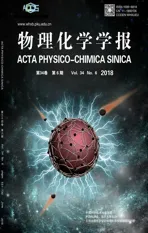An Alternative Approach to Extend Levy Constrained Search in Fock Space to No Integer Electron Number in Density Functional Theory
2018-03-08LIUShubin
LIU Shubin
Research Computing Center, University of North Carolina, Chapel Hill, NC 27599-3420, USA.
Email: shubin@email.unc.edu
The Hohenberg-Kohn theorem in density functional theory, as originally formulated, states that if an electron density, ρ0(r), is the nondegenerate ground state density of an N-electron system with external potential v0(r), where N is a positive integer, then ρ0(r) is not the ground-state density for any other electronic system1. This implies that the external potential is a functional of the ground-state electron density, and provides the foundation for density-functional theory (DFT). However, defining a practical variational method for optimizing the electron density requires that one consider electron densities associated with degenerate ground states, electron densities that are not the ground state for any electronic system, and electron densities that have noninteger electron number. The Levy constrained search2, and its extension to the grand canonical ensemble by Perdew, Parr, Levy, and Balduz3, were the first (but by no means the only4–7) theoretical frameworks that provided these extensions. These approaches allow one to determine the ground-state energy and electron density by minimizing the electronic energy functional over the set of all nonnegative integrable densities. They do this by extending the domain of the Hohenberg-Kohn functional, F[ρ], from the set of nondegenerate v-representable integer-N densities to the set of all nonnegative integrable electron densities
The Hohenberg-Kohn theorem is also restricted to ground state electron densities. The integer-N Levy constrained search functional also works for excited-state electron densities that are not ground-state electron densities8, and can be extended to other excited states by a variety of techniques9–20. Similarly, the extension of the Levy constrained search to Fock space will also work for an excited state if it is not the ground state density for any electronic system; this is an advantage over the traditional zero-temperature grand-canonical ensemble approach.
In the present paper (This paper is published online in the Journal of Acta Physico-Chimica Sinica, doi:10.3866/PKU.WHXB201711071)21, Professor Paul W. Ayers of McMaster University, Canada, and Professor Mel Levy of Tulane University, USA, present a new way to extend the domain of F[ρ], based on the generalization of the Levy constrained search to Fock space. Fock space is the direct sum of the integer-N-electron Hilbert spaces, so wavefunctions in Fock space can have an (expected value for the) number of electrons that is not an integer. This allows the traditional integer-N Levy constrained search functional for the wavefunction to be extended to fractional electron number in a straightforward way. Specifically, the Levy constrained search functional searches over all wavefunctions in the N-electron Hilbert space with the target electron density, finds the wavefunction that has the smallest value for the sum of the electronic kinetic energy and electron-electron potential energy,F = T + V ee, and defines F Levy[ρ] as that value2,22. The new function, F Fock[ρ], is defined in the same way: the only change is that the constrained search is over all wavefunctions in the Fock space that have the target electron density. While the Fock-space constrained search functional gives, as it must, the same results as the zero-temperature grand canonical ensemble functional for electronic ground states, it may be easier to derive properties of the exact functional from this new approach22. (It is generally easier to derive properties of the traditional Levy constrained search functional than it is to derive properties of alternative functionals based on ensembles or Legendre transformation.23)Whether the Fock-space Levy constrained search functional can also be extended to arbitrary excited states, perhaps using the same strategies that were used to extend the integer-N Levy constrained search to excited states, is an almost24completely unexplored, but very interesting, topic for future research.
(1) Hohenberg, P.; Kohn, W. Phys. Rev. 1964, 136, B864.doi: 10.1103/PhysRev.136.B864
(2) Levy, M. Proc. Natl. Acad. Sci. USA 1979, 76, 6062.doi: 10.1073/pnas.76.12.6062
(3) Perdew, J. P.; Parr, R. G.; Levy, M.; Balduz, J. L., Jr. Phys. Rev. Lett.1982, 49, 1691. doi: 10.1103/PhysRevLett.49.1691
(4) Valone, S. M. J. Chem. Phys. 1980, 73, 4653. doi: 10.1063/1.440656
(5) Lieb, E. H. Int. J. Quantum Chem. 1983, 24, 243.doi: 10.1002/qua.560240302
(6) Ayers, P. W. Phys. Rev. A 2006, 73, 012513.doi: 10.1103/PhysRevA.73.012513
(7) Yang, W. T.; Zhang, Y. K.; Ayers, P. W. Phys. Rev. Lett. 2000, 84,5172. doi: 10.1103/PhysRevLett.84.5172
(8) Perdew, J. P.; Levy, M. Phys. Rev. B 1985, 31, 6264.doi: 10.1103/PhysRevB.31.6264
(9) Levy, M.; Nagy, A. Phys. Rev. Lett. 1999, 83, 4361.doi: 10.1103/PhysRevLett.83.4361
(10) Levy, M.; Nagy, A. Phys. Rev. A 1999, 59, 1687.doi: 10.1103/PhysRevA.59.1687
(11) Nagy, A.; Levy, M. Phys. Rev. A 2001, 63, 052502.doi: 10.1103/PhysRevA.63.052502
(12) Nagy, A.; Levy, M.; Ayers, P. W. Time-Independent Theory for a Single Excited State. In Chemical Reactivity Theory: A Density Functional View; Chattaraj, P. K., Ed.; Taylor and Francis: Boca Raton, FL, USA, 2009; p. 121.
(13) Ayers, P. W.; Levy, M. Phys. Rev. A 2009, 80, 012508.doi: 10.1103/PhysRevA.80.012508
(14) Ayers, P. W.; Nagy, A.; Levy, M. Phys. Rev. A 2012, 85, 042518.doi: 10.1103/PhysRevA.85.042518
(15) Ayers, P. W.; Levy, M.; Nagy, A. J. Chem. Phys. 2015, 143 (19), 4.doi: 10.1063/1.4934963
(16) Gorling, A. Phys. Rev. A 1999, 59, 3359.doi: 10.1103/PhysRevA.59.3359
(17) Gorling, A. J. Chem. Phys. 2005, 123, 062203.doi: 10.1063/1.1904583
(18) Theophilou, A. K. J. Phys. C 1979, 12, 5419.
(19) Gross, E. K. U.; Oliveira, L. N.; Kohn, W. Phys. Rev. A 1988, 37,2809. doi: 10.1103/PhysRevA.37.2809
(20) Oliveira, L. N.; Gross, E. K. U.; Kohn, W. Phys. Rev. A 1988, 37,2821. doi: 10.1103/PhysRevA.37.2821
(21) Ayers, P. W.; Levy, M. Acta Phys. -Chim. Sin. 2018, 34 (6), 625.doi: 10.3866/PKU.WHXB201711071
(22) Levy, M.; Perdew, J. P. Phys. Rev. A 1985, 32, 2010.doi: 10.1103/PhysRevA.32.2010
(23) Levy, M.; Perdew, J. P. NATO ASI Series, Series B 1985, 123, 11.
(24) Ayers, P. W. Ph.D. Disseration, University of North Carolina, Chapel Hill, NC, USA, 2001.
